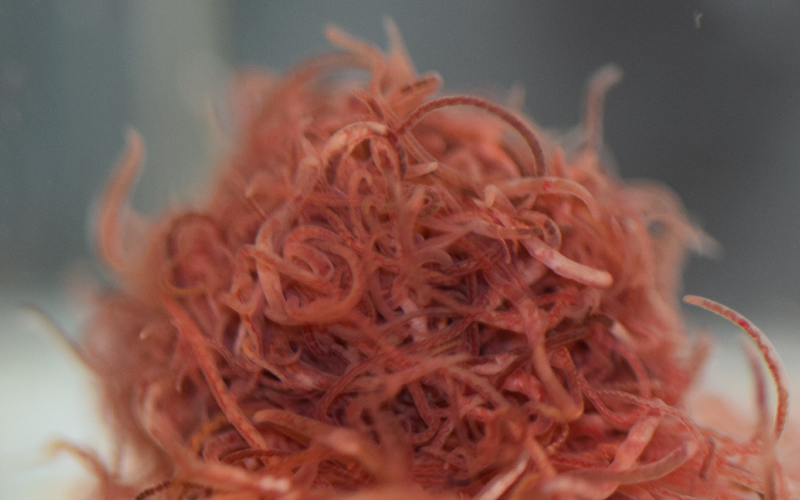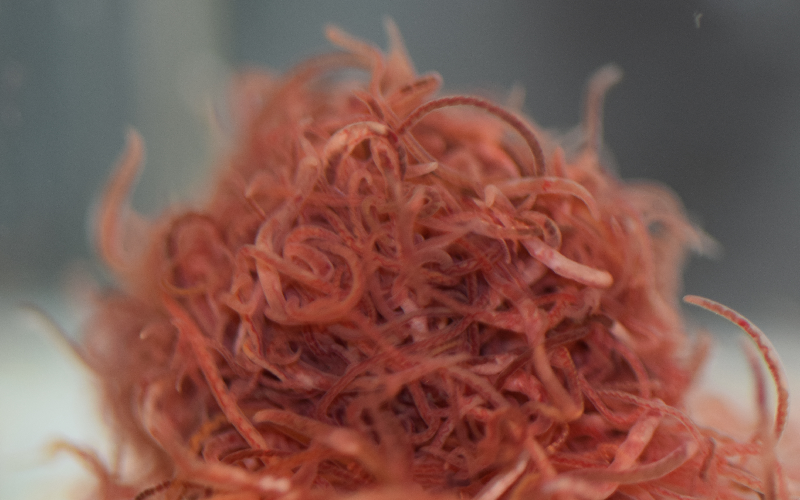Worm Viscosity
Wriggling worms could offer physicists a new means for studying “active” systems composed of large numbers of self-driven particles. Researchers placed live sludge worms—a variety of worms sold as fish food—in water and measured the viscosity of the worm-filled solution under various conditions. To control the level of worm activity, the team varied the temperature or added a dash of alcohol to the water. The viscosity of active worm solutions was dramatically different from that of inactive worms, suggesting that these worms could serve as a model of bacteria, cellular filaments, and other active matter systems.
Active systems consist of particles that move on their own by using stored energy or by converting energy from their surroundings. “The intrinsic far-from-equilibrium character of this active matter is at the origin of a plethora of fascinating phenomena,” says Antoine Deblais from the University of Amsterdam. For example, swimming bacteria self-organize into intricate patterns, and active filaments in a biological cell perform complex maneuvers that allow the cell to move or change shape.
Researchers try to simulate active matter with particles like beads or rods that can be driven with electrical or chemical mechanisms. However, many biological systems consist of polymer-like filaments that actively change their shape. The study of this type of active matter has been hampered by the lack of a macroscopic model that allows researchers to observe and control the individual filaments. Deblais and his colleagues propose to fill this gap with sludge worms, which are thin, centimeter-long worms that can be bought at any pet store.
To investigate the worms’ collective behavior, the team combined a handful of worms with a roughly equal volume of water and then performed a common viscosity test. They placed the worm-filled concoction in a cylindrical container and applied a shear force by rotating the top plate as it pressed on the liquid surface. Previous work has shown that a polymer-filled solution will resist a shear force more than a simple liquid. This increased viscosity results from the tangling of the polymer filaments. But as the shearing increases, the filaments will tend to align with each other, and the viscosity will drop—an effect called shear thinning. However, less is known about what will happen when the filaments move on their own.
The researchers controlled the activity of the worms by varying the temperature in the cylinder between and . But the team also wanted a baseline with completely passive worms. The obvious answer would have been to kill the worms, but the team found a reversible (and more humane) option. Adding 5% alcohol to the surrounding water made the worms completely motionless, but only temporarily. “After half an hour, in pure water again, they are completely sobered up,” Deblais says. “Sometimes it’s better to be a worm.”
At low shearing rates of about 1 rotation per minute, the active worm solution was 10 to 100 times less viscous than the passive worm solution. A possible explanation for the lower viscosity is that the worms’ movement helps them “relax” any tangles that form. To support this hypothesis, the team observed individual worms and measured how fast they changed shape. By comparing these shape measurements with a polymer model, they found theoretical evidence that active worms produce faster relaxation.
As the shearing rate increased, all of the solutions exhibited decreasing viscosity, as expected from the principle of shear thinning. However, the active worms showed less shear thinning. In fact, at the highest shearing rates, corresponding to several turns per second, the viscosity of the active worm solutions surpassed that of their passive counterparts, presumably because the worm movements prevented them from aligning with each other. These findings contradict recent theoretical simulations of active polymers, which predicted that shear thinning would increase with activity. The theory in this case assumed that polymer motion consists mostly of bending (orthogonal drive) [1], but the team believes that a model involving stretching and contracting (tangential drive) might better represent the worm movements [2].
Active matter expert Denis Bartolo from the École Normale Supérieure in Lyon, France, thinks these worm experiments are very original. “While liquid crystals, gels, and colloidal systems now have their active counterparts, very little was known about the dynamics and mechanics of active polymeric networks,” he says. He believes the worms offer a valuable platform for developing a theory of active polymers.
This research is published in Physical Review Letters.
–Michael Schirber
Michael Schirber is a Corresponding Editor for Physics Magazine based in Lyon, France.
References
- A. Martín-Gómez et al., “Active Brownian filaments with hydrodynamic interactions: conformations and dynamics,” Soft Matter 124, 188002 (2019).
- Ö. Duman et al., “Collective dynamics of self-propelled semiflexible filaments,” Soft Matter 14, 4483 (2018).





